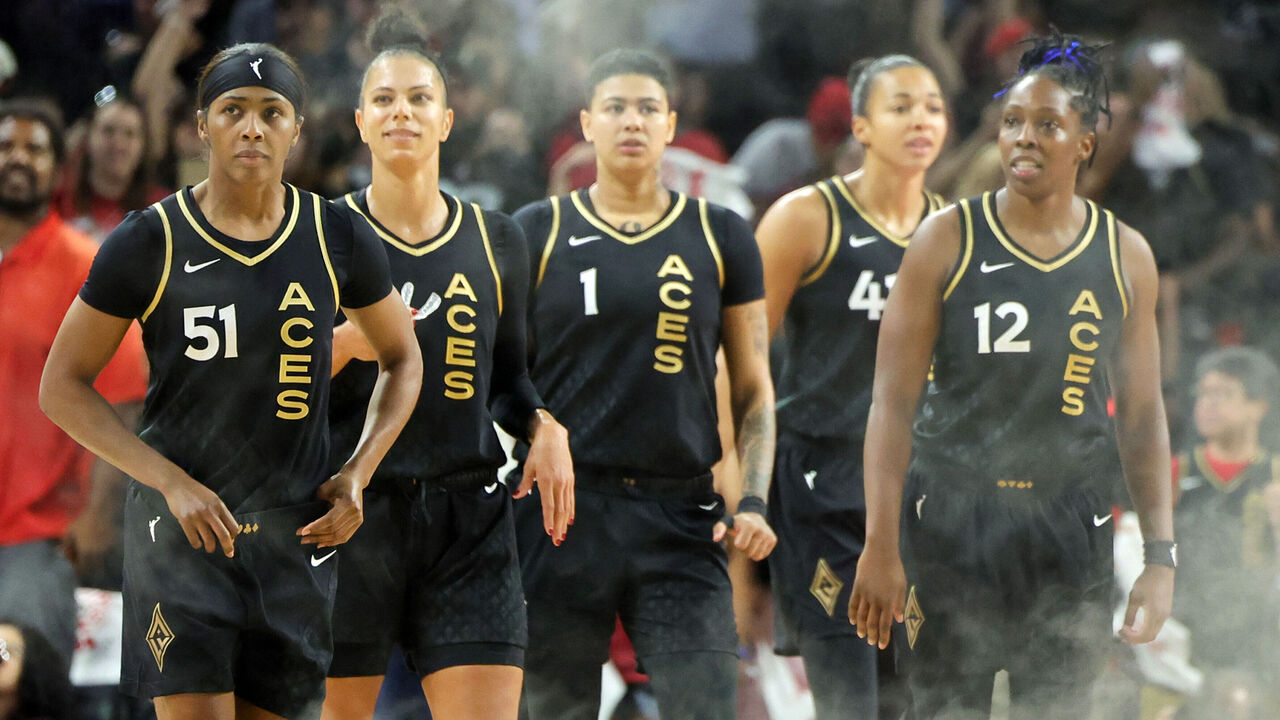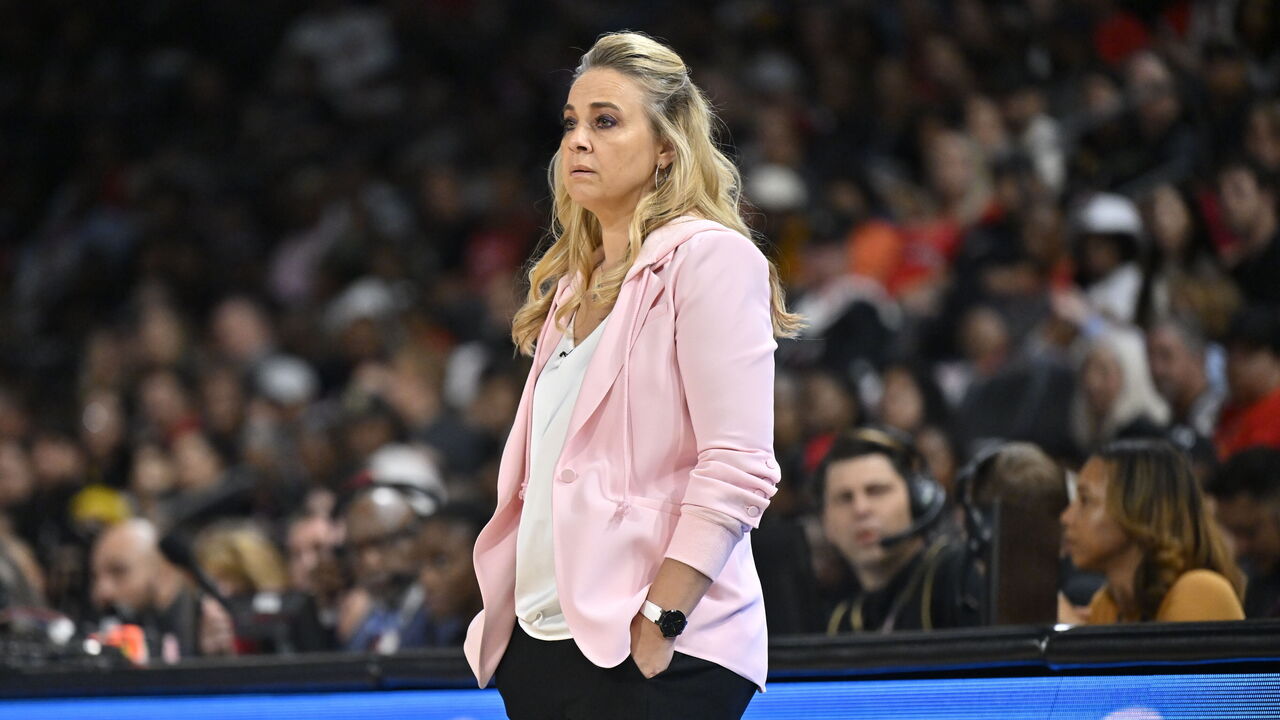What the Aces superteam could mean for the WNBA's growth as a business
If all goes according to plan for the Las Vegas Aces, three weeks from now they will have achieved a feat that has remained elusive for more than 20 years: securing consecutive WNBA championships. It would serve as the crowning achievement in an exceptional year for the team, marked by the inauguration of a cutting-edge facility, the signing of the league's first million-dollar-a-year coach, and the acquisition of superstar talent.
The significance of the achievement could extend far beyond just rings, a banner, and a trophy. Repeating as champions could be the start of a dynasty - and dynasties attract dollars.
Dynasties have set the market for decades. The New York Yankees established baseball's bottom line on the field and off it, dating back to the 1920s. The Montreal Canadiens were hockey's standard-bearers throughout the middle of the last century. The Steelers, Cowboys, and Patriots earned national fan bases because of their sustained runs of success in the Super Bowl era. And in the NBA, the Lakers and Celtics ascended to global brands while racking up 17 championships apiece.
While winning isn't rewarded equally in all sports leagues, it can be a major boon for some teams. In the modern NBA, a championship run can bring in tens of millions of dollars, and a sustained run of success can add hundreds of millions to its franchise valuation. In the 2021-22 season, the Golden State Warriors raked in the highest operating income in the NBA by 33%, coming in at a whopping $206 million. Compare that to the 2010 Warriors, who netted just $22.2 million in operating income.
What changed in that time? The Warriors got good. Deep playoff runs became an expectation. Those annual extra 10 or 12 home playoff games, for the better part of a decade, translated into an extra $750 million in income. They were indeed also helped by the NBA's revenue-sharing plan, which allows teams to keep a greater portion of playoff income - 75% instead of 55% in the regular season.
Their achievements on the hardwood reshaped the Warriors' image and resulted in a substantial increase in franchise value. Forbes assesses them to be worth $7 billion today, making them the most valuable franchise in the NBA. Back in 2010 when the Golden State Warriors sold for what was then a record $450 million, the sale looked exorbitant, considering just seven months earlier they had been valued 18th in the league, at a measly $315 million. That $450 million price tag looks like a slam dunk investment today.

The WNBA hasn't had a repeat winner since the Los Angeles Sparks in 2001 and 2002. The now-defunct Houston Comets earned the first four rings at the dawn of the WNBA. More recently, the Minnesota Lynx collected four championships - without repeating - in a seven-year span between 2011 and 2017.
"You look at a seven-year stretch of some pretty incredible playoff series - I thought, each year, there was something special," said Cheryl Reeve, who has coached the Lynx since 2010. "The Minnesota Lynx have been a franchise that has been able to build on its fan base. There's no question winning and how we do it as a team is important."
As the league's profile expands and it draws more attention from television and advertisers, what could a new dynasty mean?
The Aces are the team that's best positioned to step into that role. They owned the best regular-season record in the league at 34-6, and they sliced through the Chicago Sky in two games to advance out of Round 1 of the playoffs. Now, they're inching closer to adding another chip, and the anticipation for what this could mean for the sport - and the Aces' legacy - is building.
Unlike other sports that can cover their operating expenses with the money from national TV deals, a lot of WNBA team revenue - from ticket sales to merchandise, food and beverage sales, and sponsorships - is used to fund player salaries. The longer a playoff run, and the more consistently a team makes the playoffs, the more cash in that piggy bank. Fan purchasing behavior isn't arbitrary; there's a science to it, much of which revolves around a team's on-court performance.
While fans may initially support a team due to a sense of identity, people tend to identify most with winning. This phenomenon, known as "basking in reflected glory," refers to the satisfaction derived from publicly affiliating with successful entities. When it comes to sports teams, research unequivocally establishes a tangible connection between exceptional team performance or individual star players and increased sales of team merchandise.

A long playoff run also gives a larger group of fans time to fall in love with new heroes. Research shows a heightened sense of drama is essential to creating storylines fans need to tune in for. Rivalries - the hero versus villain motif - foster fan engagement and drive viewership.
Throughout the 2010s, the Lynx versus Sparks rivalry defined the competitive landscape and filled this need in the WNBA. The teams met in the Finals in 2016, when the Sparks took home the hardware, and 2017, when Reeve coached the Lynx to their most recent championship. "I thought that rivalry really created a lot of interest in the W," Reeve said. "Obviously, the fan bases were extremely passionate. We brought out the best in each other, or the worst in each other."
Increased viewership driven by rivalries can boost league revenues. WNBA athletes receive 50% of the league's incremental revenue after the league has reached certain targets that it doesn't make public. What we do know about the revenue targets is that they increase by 20% each year - so the league needs to grow at a substantial pace for players to earn their cut of the revenue. If dynasties and rivalries lift revenue, players stand to earn more of that in better facilities, better salaries, and upgraded travel, which has been a focus for players in recent years. Big storylines that drive viewership can potentially be a boon for the entire league. They're so important that in situations where the competition is lackluster, commentators tend to inject hypothetical rivalries, heroic narratives, power struggles, and intrigue.
But the Aces don't need to rely on conjuring them up. They're forming their heroes in real time. Superstars like A'ja Wilson, Kelsey Plum, Chelsea Gray, Alysha Clark, and Candace Parker (out with a foot injury), along with coach Becky Hammon, have given the fans veritable playmakers to cheer for. This could be the sort of storyline that builds the already growing WNBA audience. The Aces also have a burgeoning rivalry with the New York Liberty - the other superteam on the block, featuring stars such as Sabrina Ionescu, Breanna Stewart, and Jonquel Jones. The semifinals for both teams - Las Vegas faces the Dallas Wings and New York faces the Connecticut Sun - begin Sunday.
So, can the Aces keep cruising past their rivals to secure a repeat and birth an all-important dynasty?

"We have some experience; we know we're battle-tested. I think we're confident. I know we're prepared. Now, it's just a matter of going out and executing it," Hammon said before Game 1 against the Chicago Sky at Michelob Ultra Arena in Las Vegas.
But before Hammon and her crew get too tied up in thinking about what winning means for business, she's focusing on the daily business of winning.
"If you want any chance at a future, you've got to take care of the present," she said.
Jolene Latimer is a video producer and feature writer at theScore.
HEADLINES
- Blake Griffin, Candace Parker among 1st-time nominees for Naismith HOF
- WNBA players union authorized to strike if needed during CBA talks
- Toronto Tempo unveil jerseys for inaugural season
- Watkins attends Team USA camp, focuses on leadership amid rehab
- Hamby, Aces mutually drop lawsuit over pregnancy discrimination